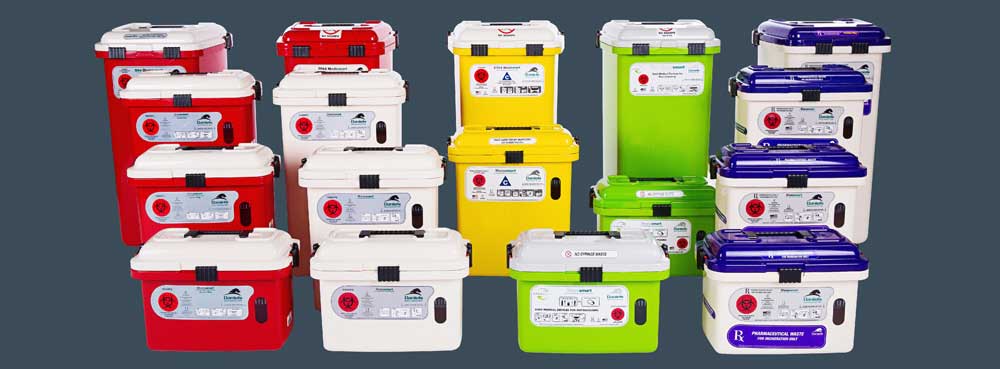What is the Difference Between Healthcare Waste Streams?

Throw, throw, throw your waste, safely and compliantly into the bin corresponding with the correct healthcare waste stream.
When we say to “throw” your waste, we mean to properly dispose of healthcare waste according to the correct waste stream. Healthcare waste “streams” describe different types of waste generated by a healthcare facility, and, if your medical waste treatment partner is on the ball – each container will be clearly differentiated by color and labelling. Being able to identify and define the difference between waste streams is key in the process of segregation, collection and transportation, as well as disposal. Proper healthcare waste segregation is essential for maintaining compliance with federal and state guidelines; failure to do so may impose fines and penalties for non-compliance. Let’s avoid potential fines and repurpose that saved money right back into patient care!
Different types of healthcare waste streams
Healthcare waste streams are categorized primarily by the type of waste they produce. Similar to “you are what you eat”, a healthcare waste stream is what it makes. For example:
- pharmaceutical waste
- pathological waste
- sharps waste
- biological waste
- blood and/or blood related products
- microbiological waste
- contaminated animal waste
- isolation waste
Each of these medical-generated waste streams are defined by federal as well as state guidelines – what they are, what they contain, and proper collection, segregation, transportation, and disposal methods for each. While California may feel strongly and strictly about pharmaceutical waste disposal, another state could be more lax. It’s crucial to research your own state.
Pharmaceutical waste is defined as any discontinued, expired, contaminated or unused medication that has the potential to infect or otherwise prove dangerous to humans, animals, or the environment. This stream is delightfully complex. Each state has different classifications and disposal requirements. Speak with a Daniels consultant to assess if your pharmaceutical waste is just non-hazardous or something more complex. Hazardous pharmaceuticals must be specially packed, accounted for, and disposed of.
Sharps are defined as any sharp objects that can include needles, surgical blades, pipettes, or syringes—if it has the potential to puncture your skin, chuck it in the bin (kidding, please safely dispose). Contaminated sharps must be secured in a heavy-duty container to reduce the risk of accidental needlesticks during disposal. Every state has specific guidelines and regulations as to the type of sharps container used for contaminated as well as non-contaminated sharps. Daniels reusable Sharpsmart system has passed several standards confirming the safety of our containers – find them here.
Pathological waste includes tissue samples or other biological or anatomical matter. This type of waste typically results from a surgical procedure or test such as a biopsy. Simply put, this category implies anything that comes from or was a piece of a human or animal.
Biological waste is a type of medical waste that may be contaminated with or contain pathogens, infected blood, tissues, cells, cultures, blood products, or any other potentially infectious material. The definition between pathological and biological waste is often confused but the basic understanding of both is that pathological and biological waste streams contain a portion or part of something that comes from an animal or human body.
Microbiological waste is defined as a type of infectious waste or any associated biological material. Such materials may include culture dishes, a live vaccine, or similar products that come from a laboratory. As such, microbiological waste is considered a waste stream that contains materials that increase risk of infection to humans.
Isolation wastes are a type of waste stream generated from a patient (human or animal) sequestered in an isolation chamber, tent, or room in a medical facility to reduce the risk of spread of disease—such as C. Diff (Clostridium Difficile). This type of waste is also known as communicable disease waste and can include items such as bedding potentially contaminated with any type of bodily fluid. This type of waste often occurs in long-term care facilities as well. Think lots and lots of bed sheets. With so many patients being cared for in close proximity of each other, it is imperative to dispose of this waste properly so to diminish the risk of outbreak.
Human blood or other blood related products such as serum and plasma are another type of waste stream, but anything else that’s contaminated also fits into this category including bedding, clothing, or protective personal equipment such as surgical gowns and gloves. The old standby for this stream is to dispose of any material where blood or other infectious materials can be “flaked, poured, or dripped.”
The importance of compliance
 Federal and state regulatory agencies provide stringent guidelines for maintaining compliance with regulated medical waste (RMW) regulations. Regulated medical waste is also known as infectious waste or biohazard waste. This waste stream includes anything with the potential for contaminated by body fluids, blood, or another possible infectious type of material that poses a strong risk of transmitting disease or infection.
Federal and state regulatory agencies provide stringent guidelines for maintaining compliance with regulated medical waste (RMW) regulations. Regulated medical waste is also known as infectious waste or biohazard waste. This waste stream includes anything with the potential for contaminated by body fluids, blood, or another possible infectious type of material that poses a strong risk of transmitting disease or infection.
Whilst federal guidelines classify a large volume of healthcare generated waste as ‘regulated medical waste’ (otherwise known as red bag waste or RMW), every state has their own terminology and guidelines for the handling and collection, transportation, and treatment of individual waste streams. Reiterating: research your own state guidelines.
Federal and state regulatory agencies involved in compliance include:
- Environmental Protection Agency (EPA)
- Occupational Safety and Health Administration (OSHA)
- Department of Transportation (DOT)
- Drug Enforcement Agency (DEA)
Regulations at the state level can be found on state government websites. For example, in Utah, infectious waste requirements are found under the Utah Administrative Code Rule R315-316. This rule provides specific guidelines regarding storage and containment, transportation, treatment and disposal of infectious waste. In Virginia specific statutes, regulations and guidelines for medical waste management are found in Virginia Administrative Code, Title IX, Chapter 120.
Proper handling, segregation and collection of waste streams is essential for compliance. Failure to comply incurs not only financial, but legal ramifications. Fines by the EPA and other federal and state agencies can reach well into the tens of thousands of dollars for each infraction. Fines associated with improper disposal of sharps, non-compliant hazardous waste disposal, or other waste streams are equally severe. Daniels Health can provide access to our online Compliance Portal which allows for easy storage and retrieval of all relevant state and federal regulations when it comes medical waste disposal.
In any healthcare facility, whether for treatment and care of humans or animals, the responsibility for managing, identifying, and properly segregating medical waste streams falls onto the generator. Medical waste generators are also responsible for choosing properly credentialed medical waste pickup companies when it comes to healthcare waste management (and, if you generate hazardous waste, ensuring that they are licensed for hazardous waste disposal). It seems a monumental task, such responsibility, but Daniels Health is here to help.
The Daniels Difference
For compliant, sustainable, and secure disposal of all healthcare waste streams that meet federal and RCRA disposal guidelines, turn to Daniels. Our products and services are designed to reduce the risk to healthcare practitioners (and the environment) when it comes to proper segregation, collection, transportation and disposal of medical waste. Remain compliant while reducing administration burdens. Save money with proper segregation that reduces the volume of medical waste being sent to landfills. Retain funds that can be used for exceptional patient care and help take care of our planet! We all live here and we all need healthcare—let’s make both experiences enjoyable.
Let's Talk!
Your time is valuable, and we don’t want to play hard to get. You can either phone us directly on the details listed on our contact page, or feel free to fill out this short form and one of our team members will get back to you as quickly as possible.
